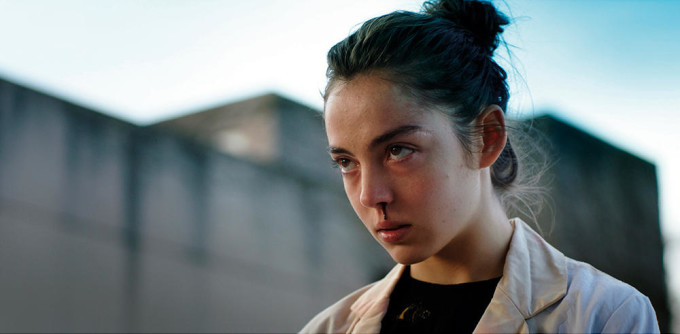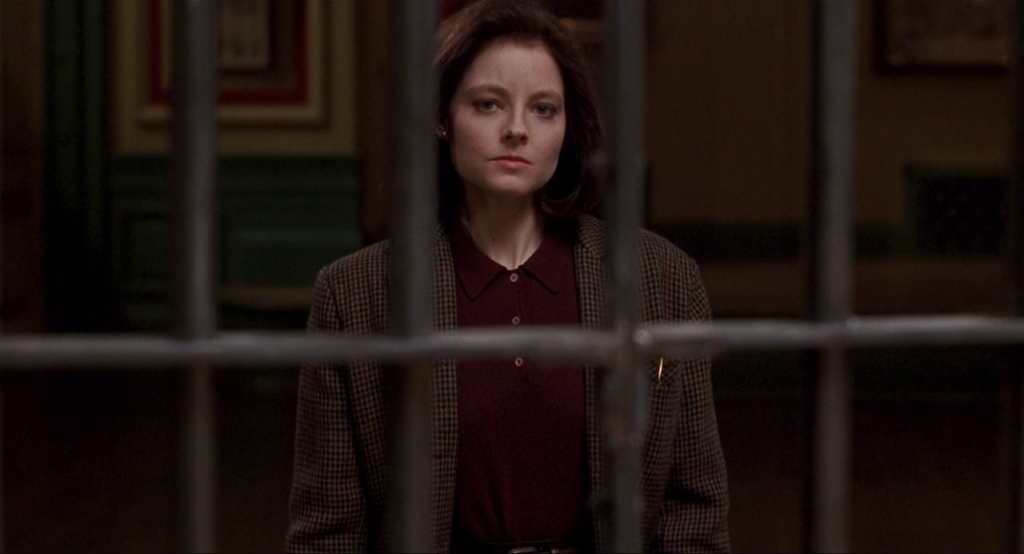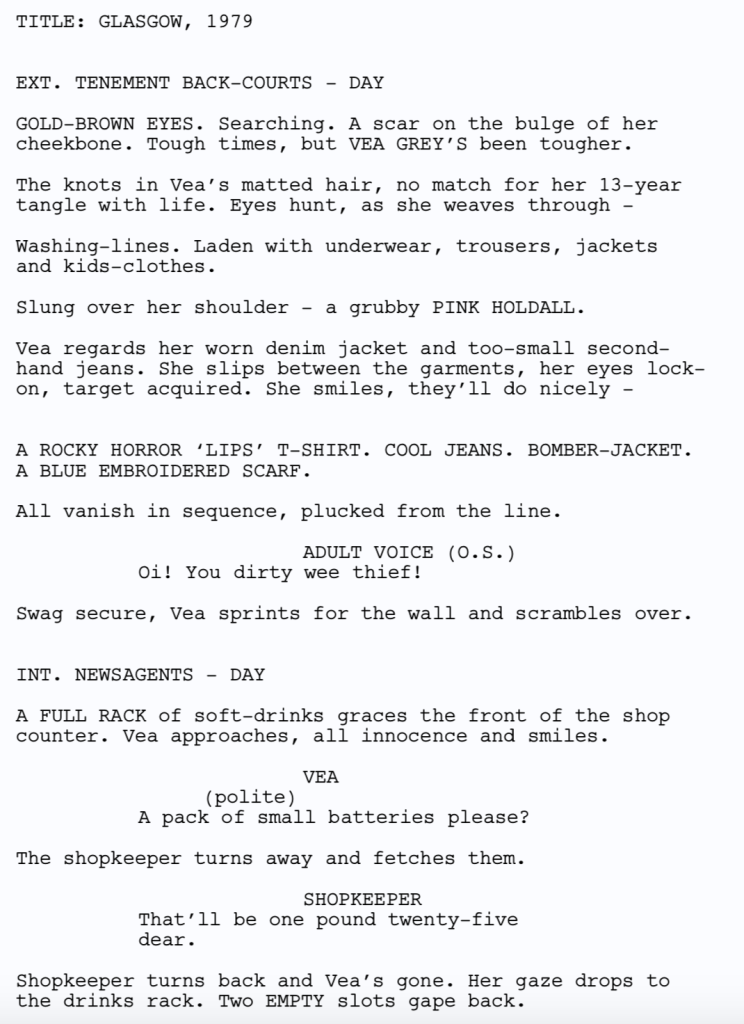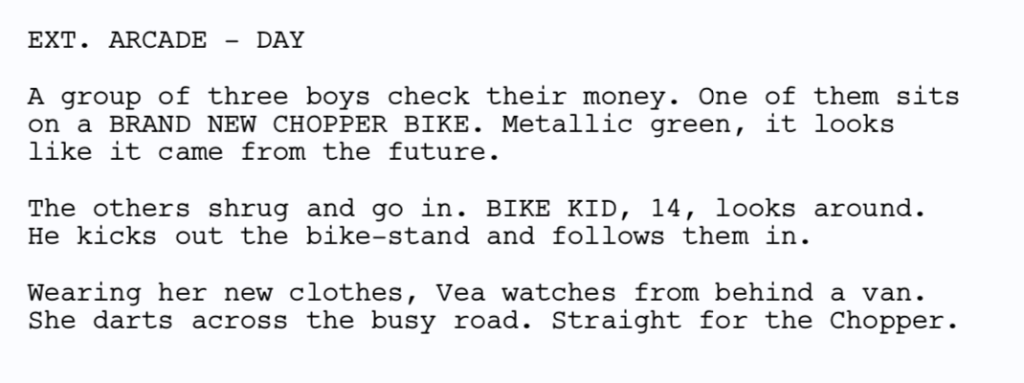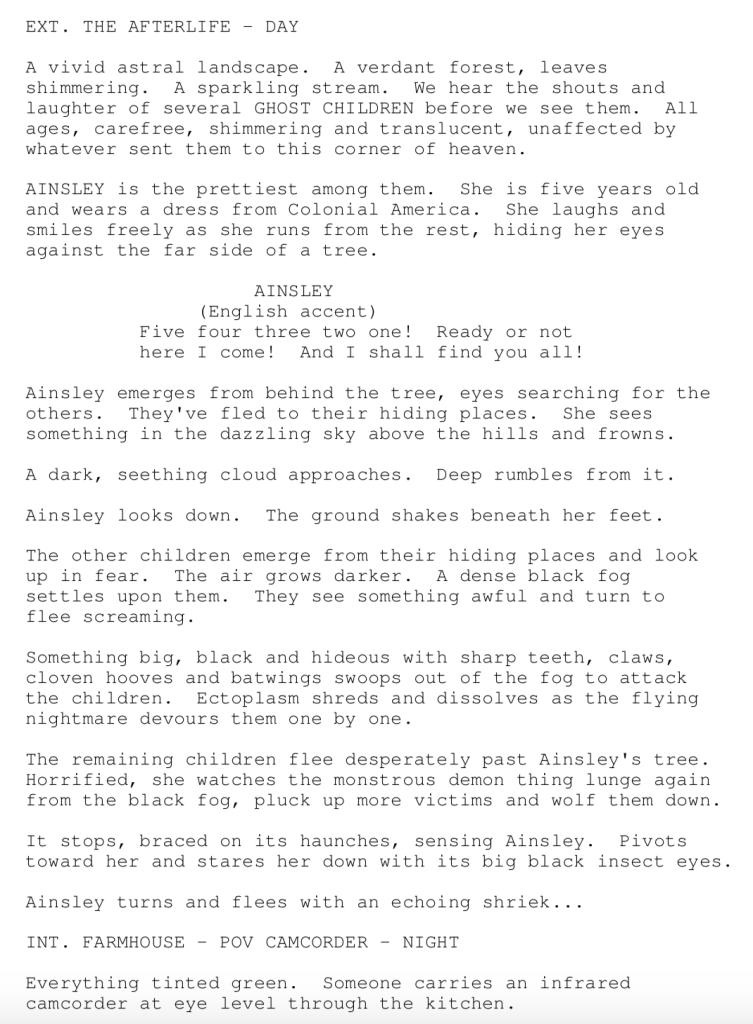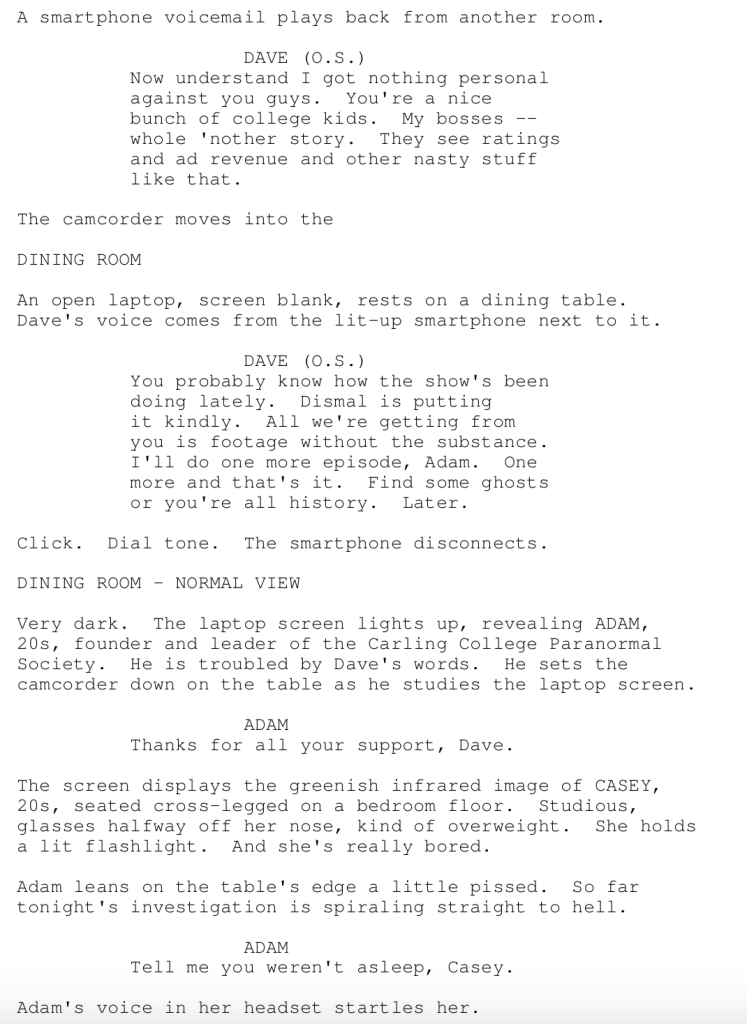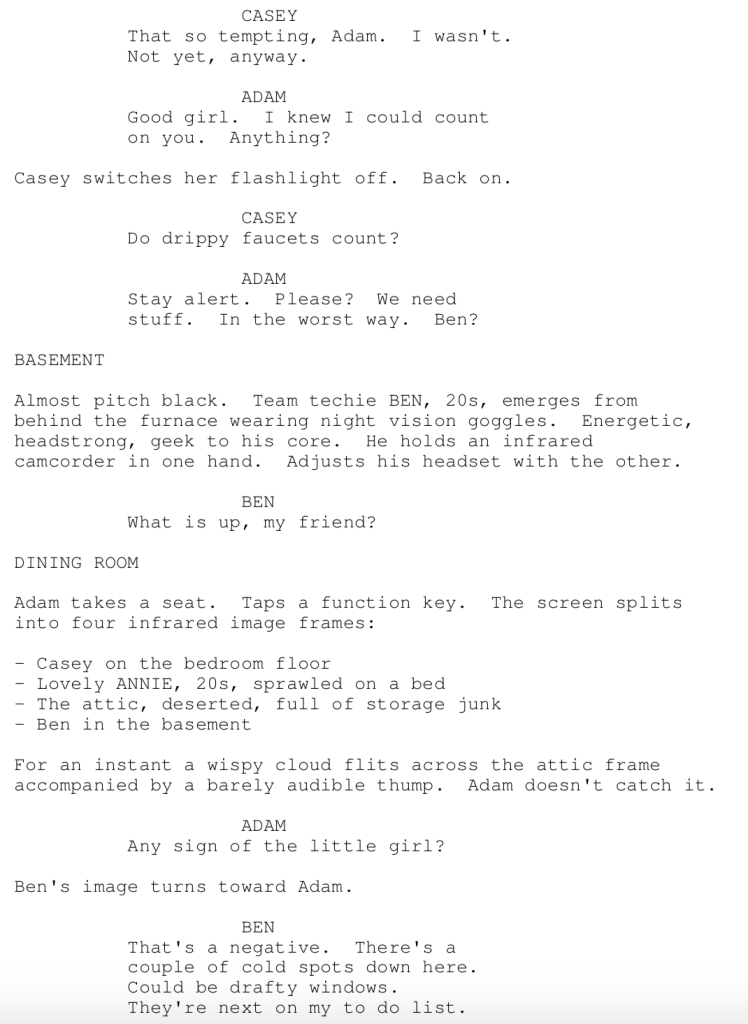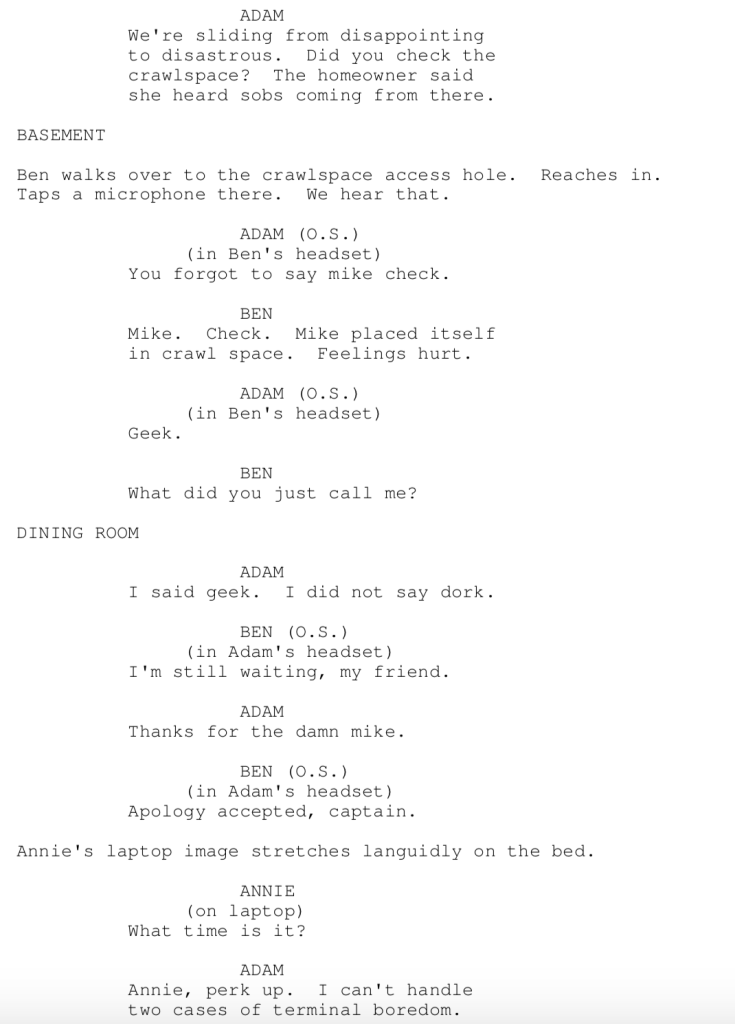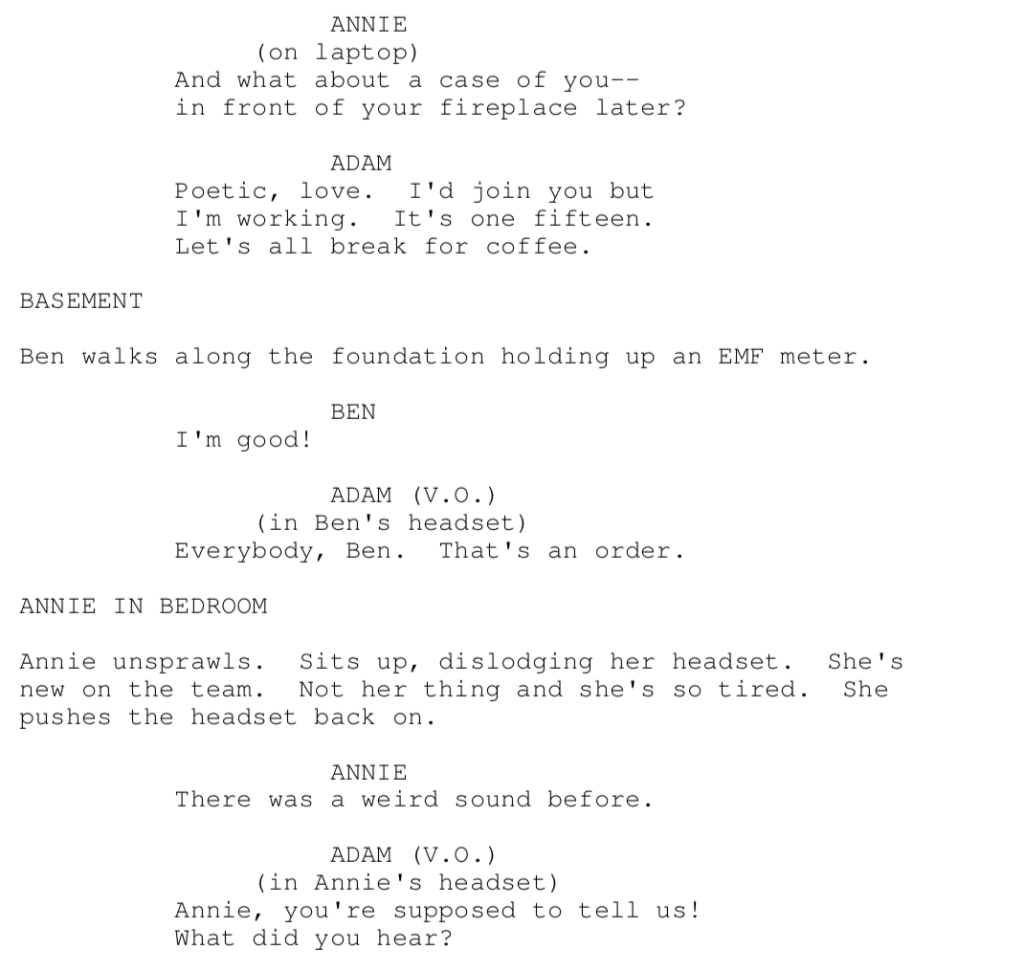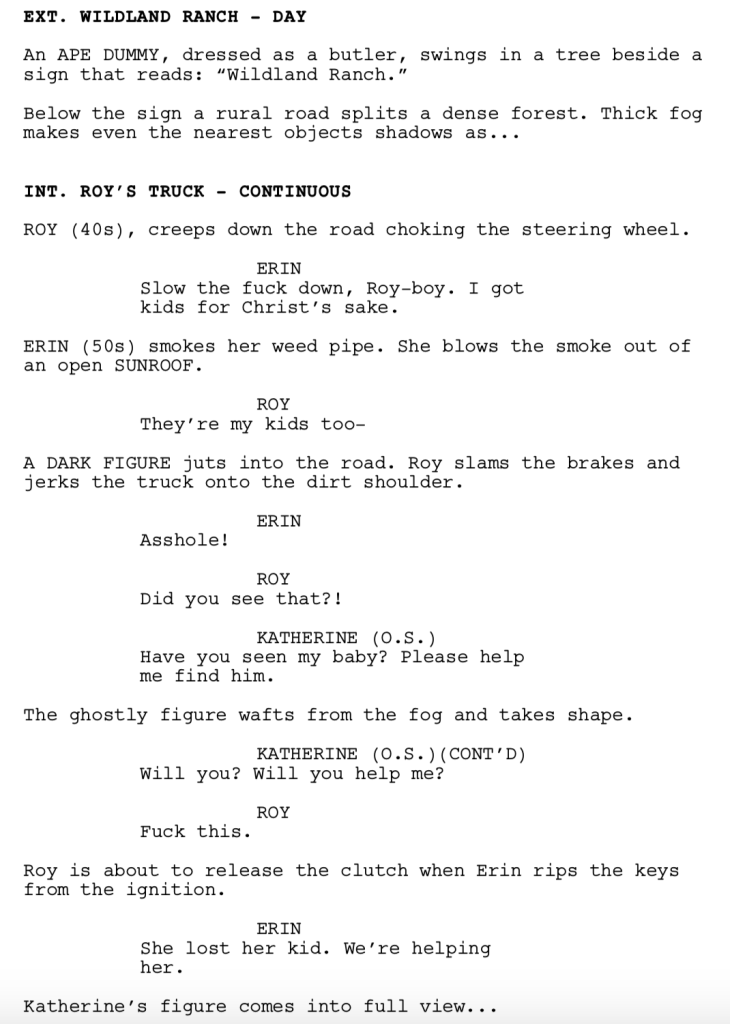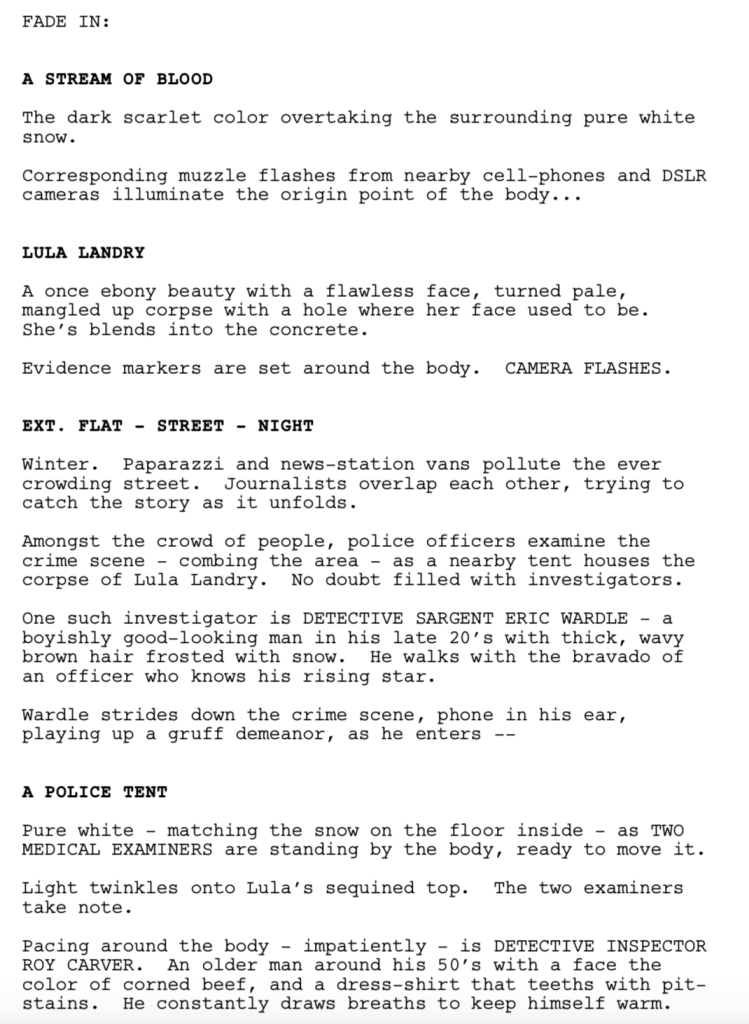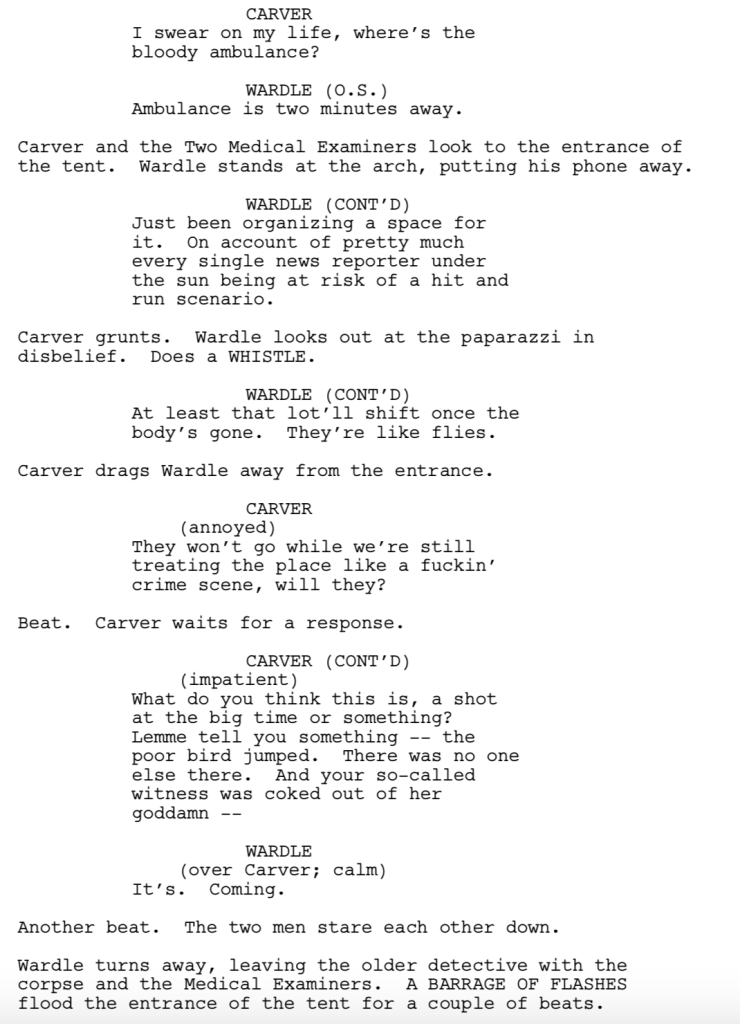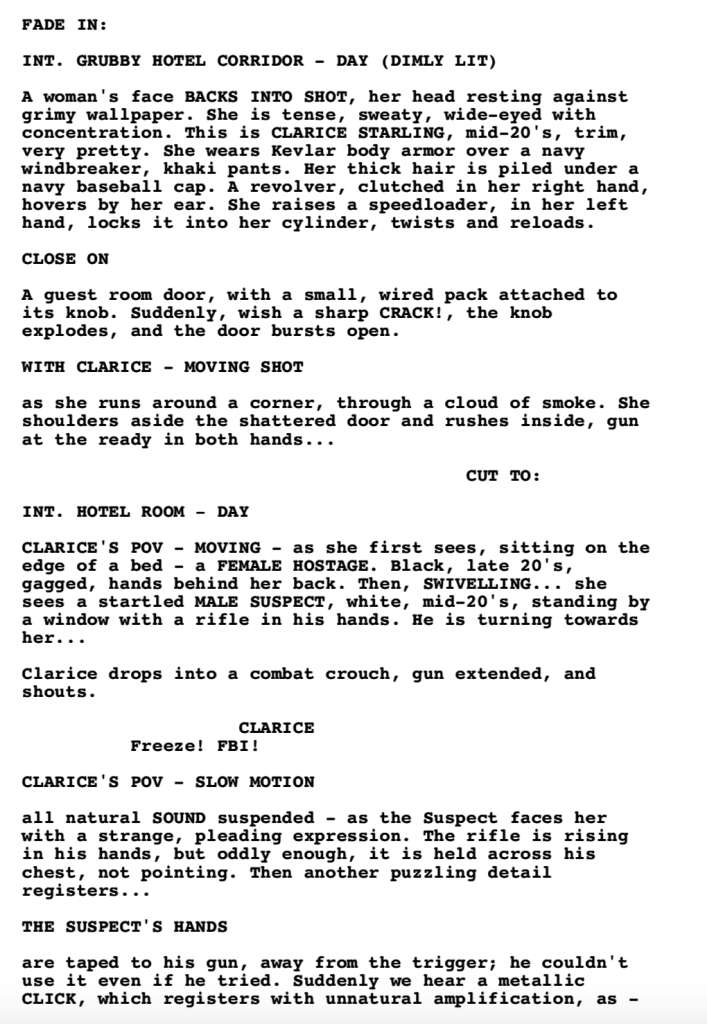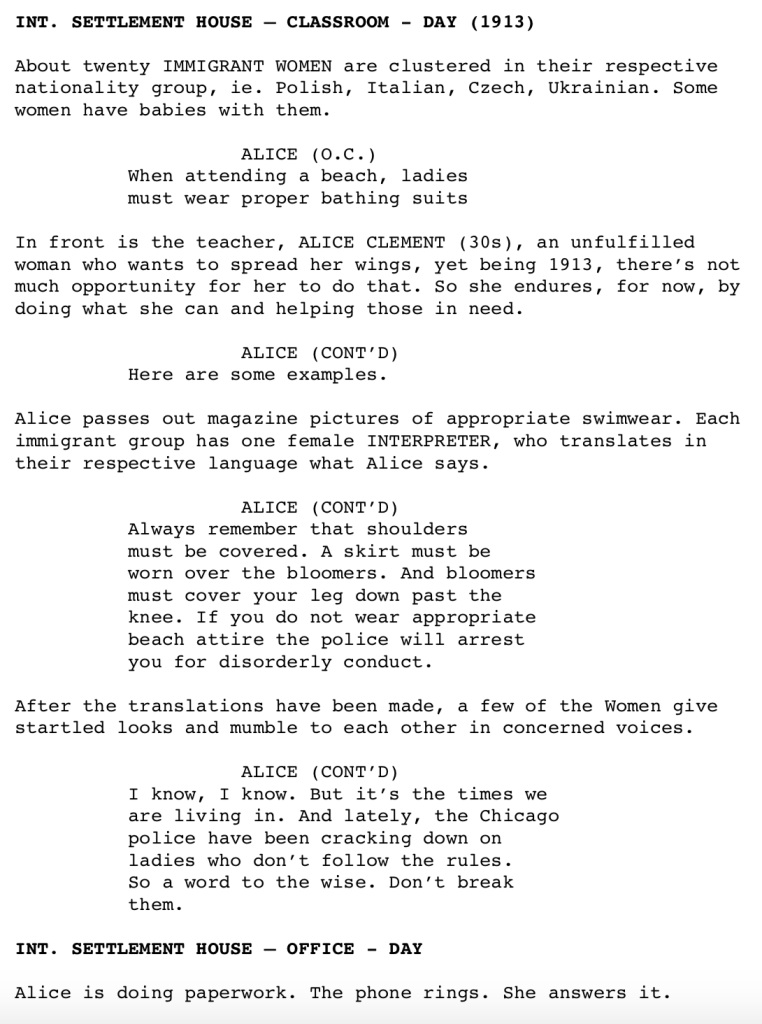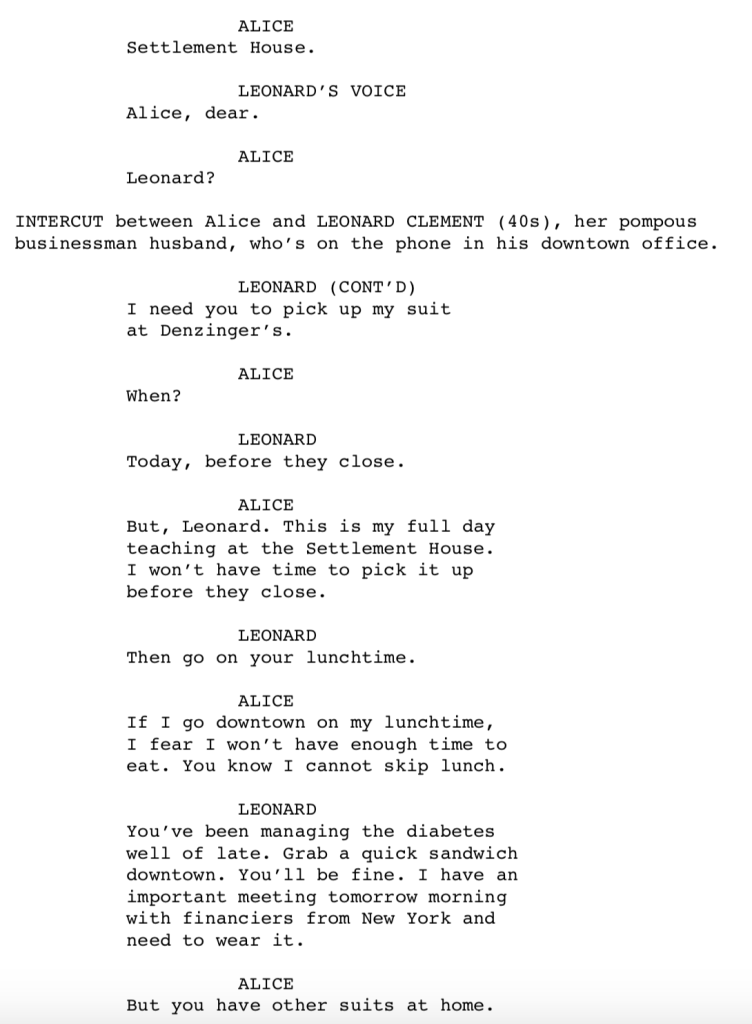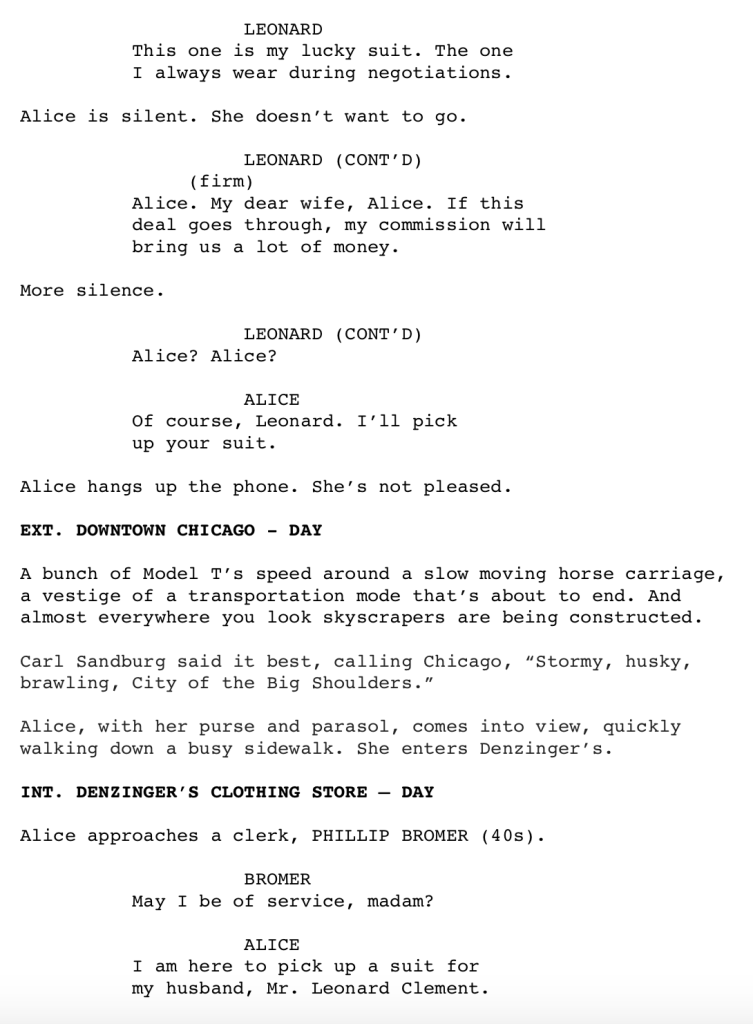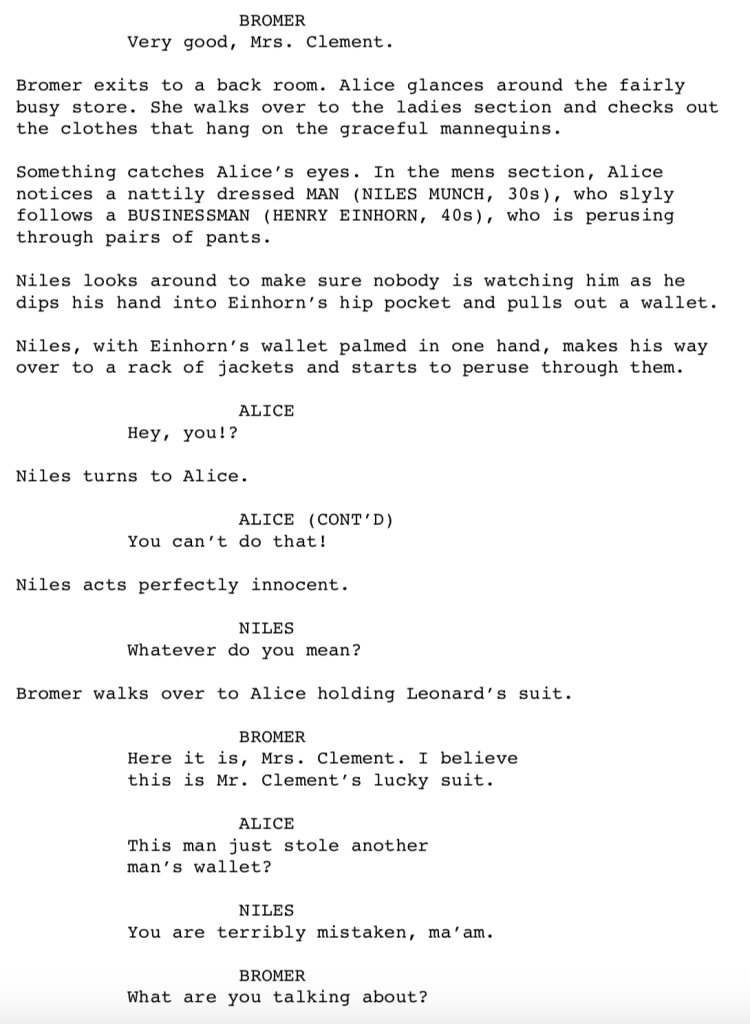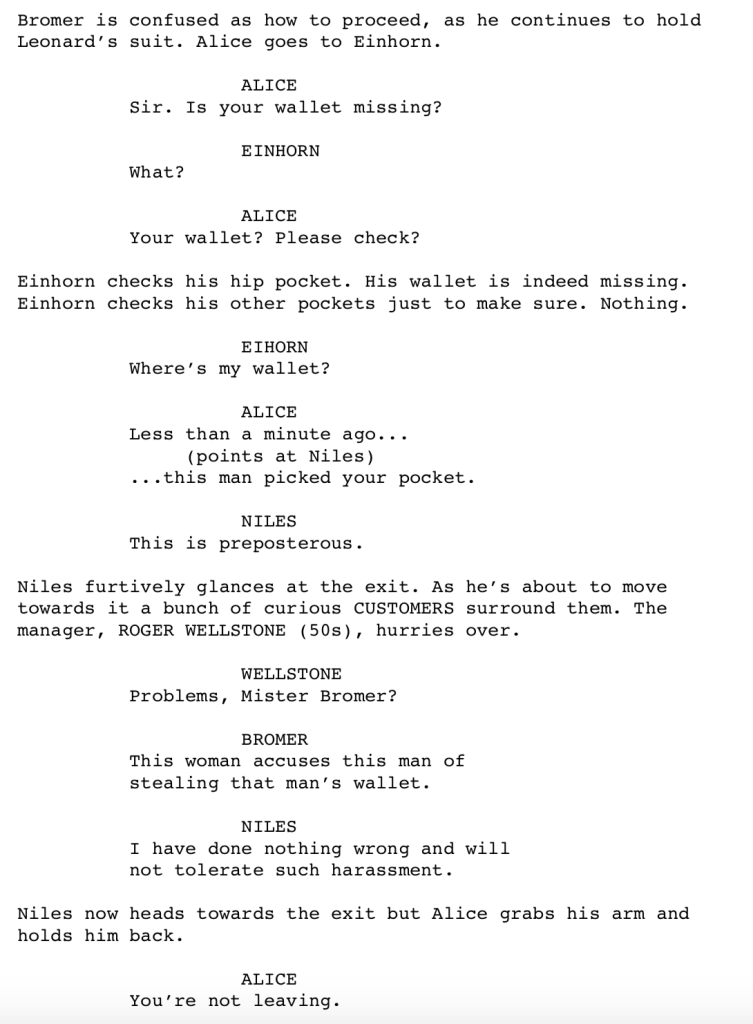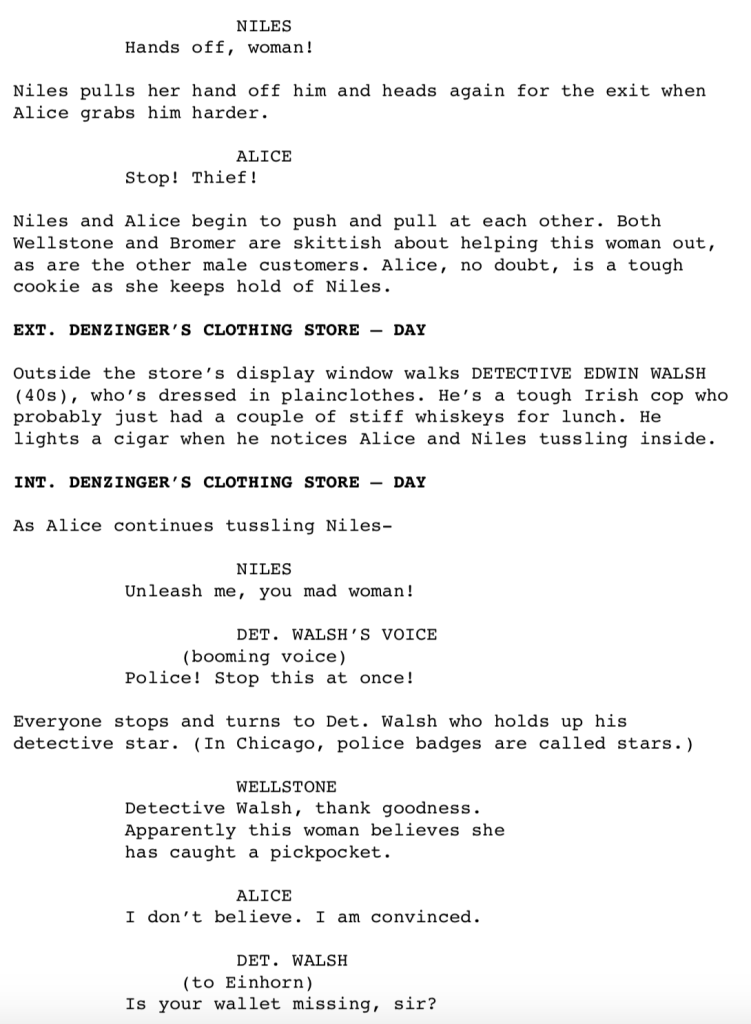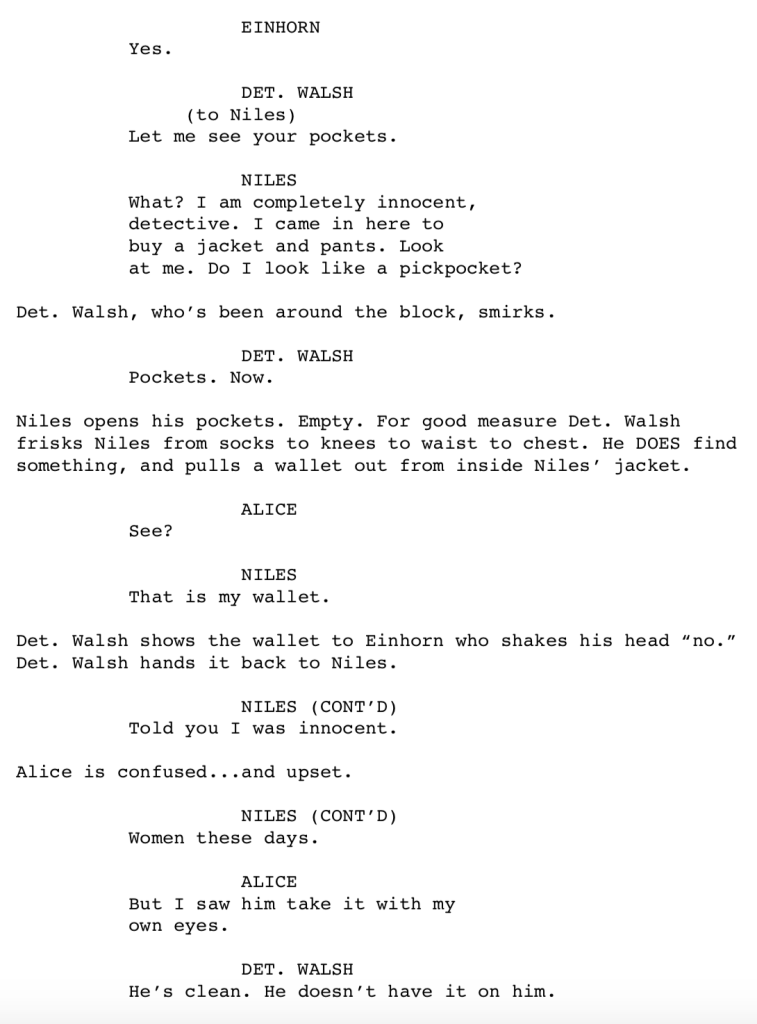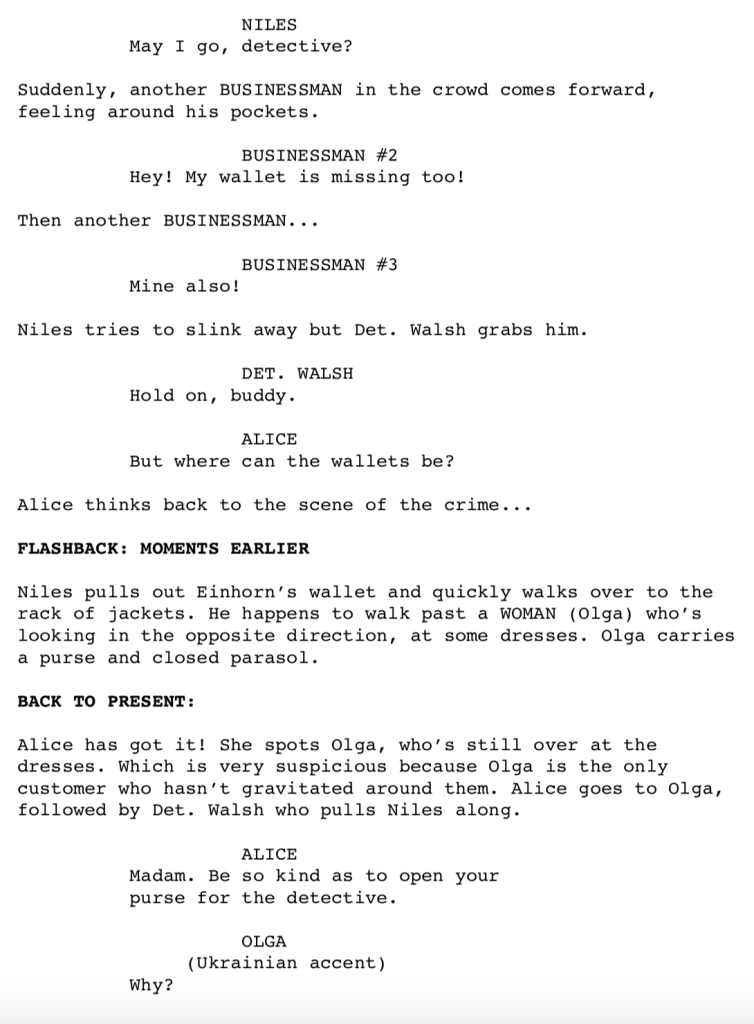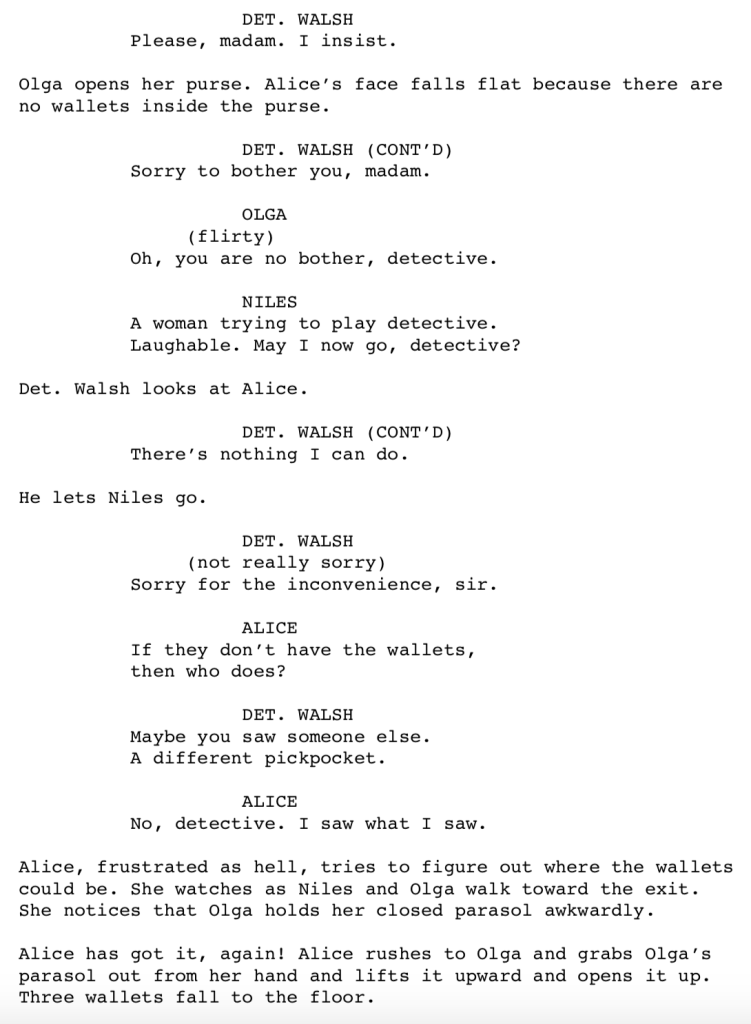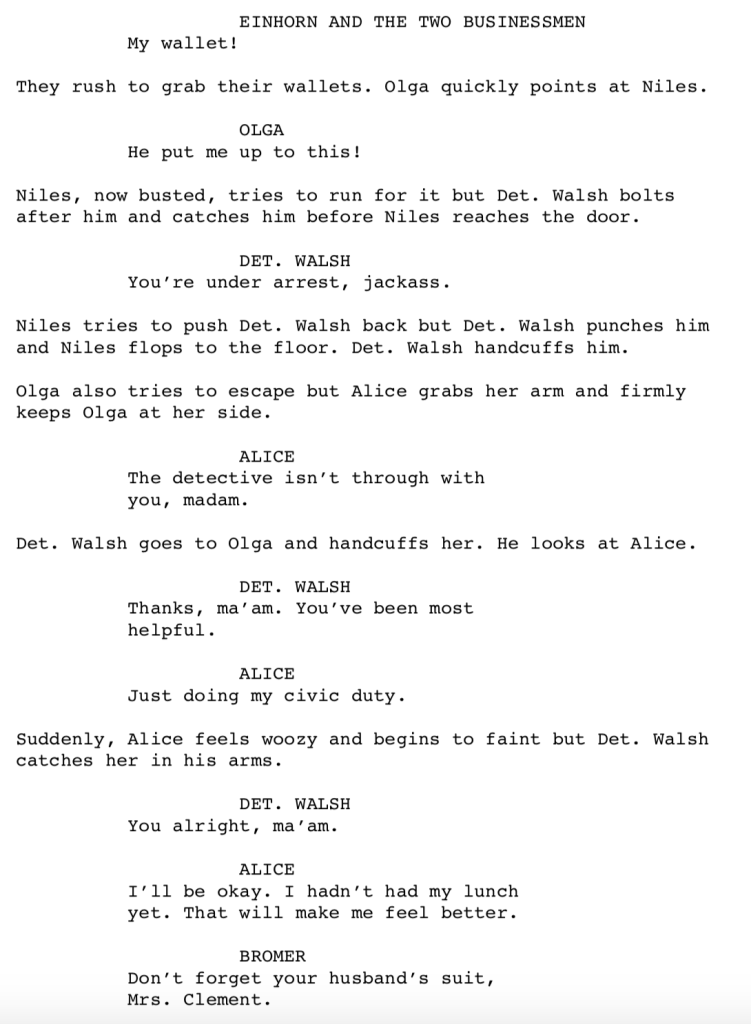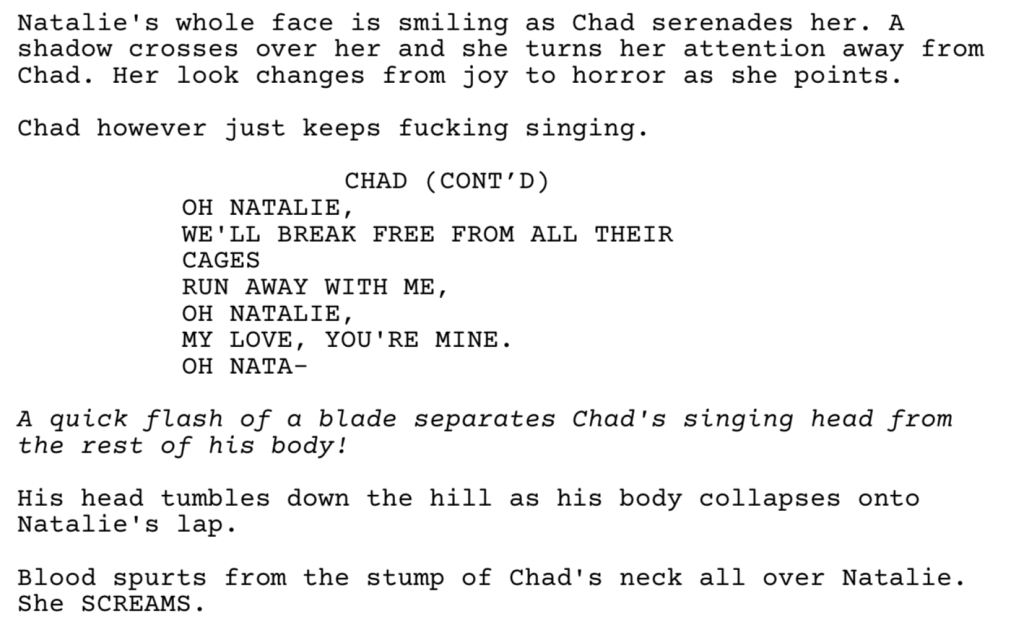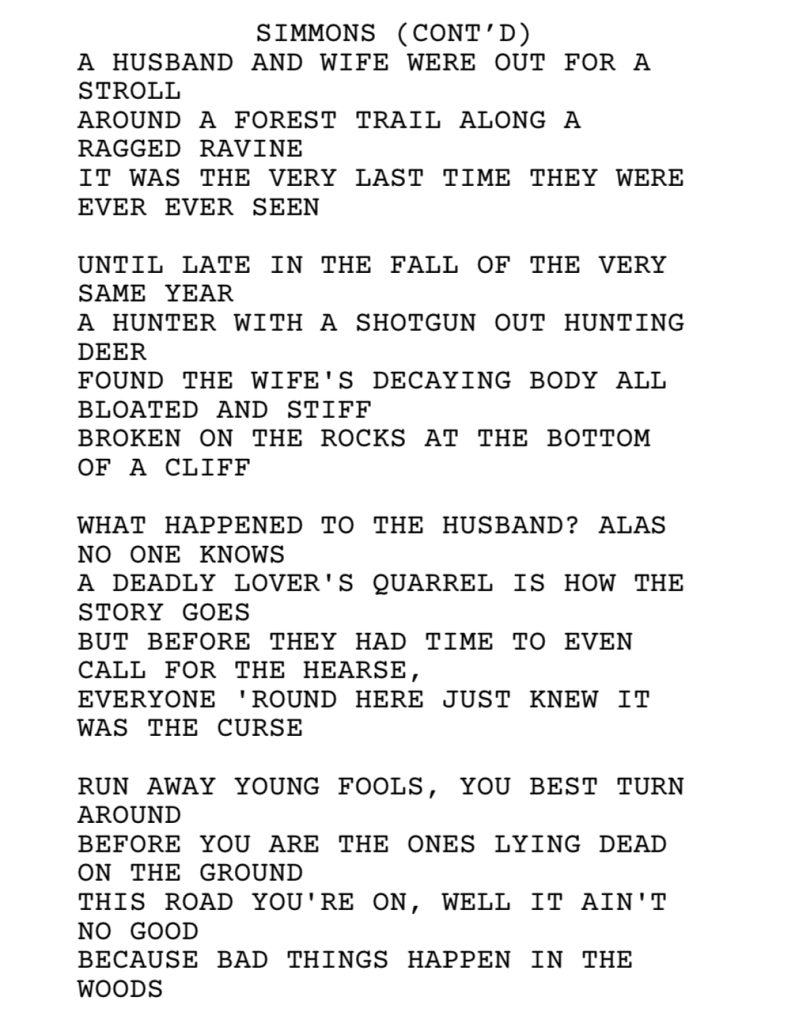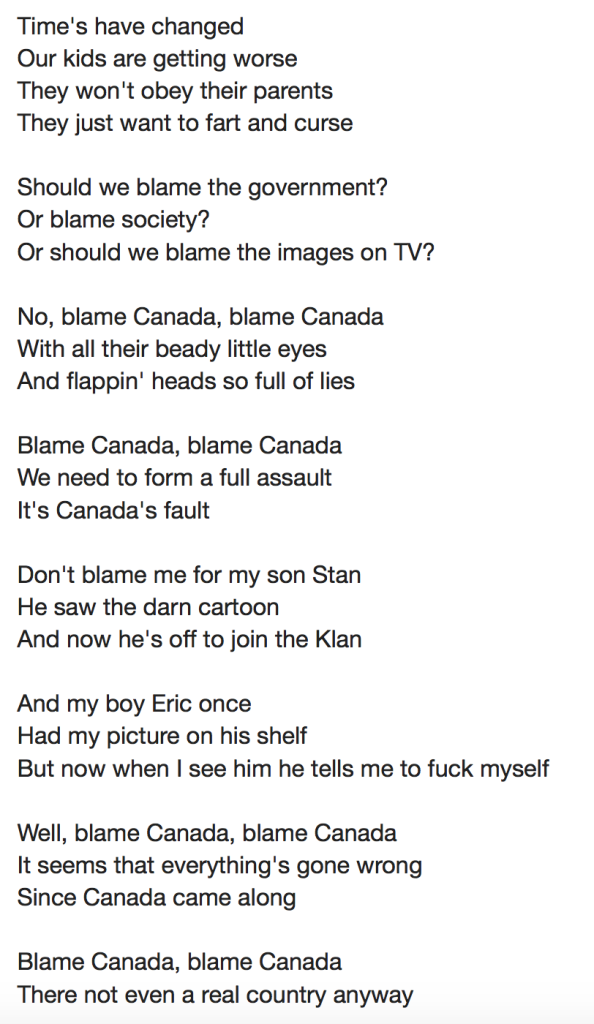Search Results for: day shift
Genre: Action/Sci-Fi/Found Footage
Premise: A group of storm chasers hoping to catch an elusive F5 tornado on camera catch something way more dangerous.
About: This script was written all the way back in 2010. It comes from screenwriters Chris Rossi and Gabriel Scott. Rossi penned a maudlin drama a few years ago called Meadowland that starred Olivia Wilde and was directed by one of the now rising female directors on the scene, Reed Moreno (whose name has been in the hat for a Star Wars project). It looks like the film ultimately fell victim to the competing found footage storm movie WB made, “Into the Storm.”
Writers: Chris Rossi & Gabriel Scott
Details: 101 pages
No.
More.
Black.
List.
For.
At least.
One.
Day.
Good Lord has that list become insufferable. And obvious. And boring. And it’s only getting worse. They’ve telegraphed so clearly what they celebrate that everyone just keeps writing the same scripts.
There’s this thing in baseball that’s occurred recently which many people are predicting will kill the sport. It’s called “the shift.” What some smarty pants MIT graduates realized was that the vast majority of the time, a hitter is going to hit the ball to the side of the field that matches his batting side. So if he’s a right hander, he’s going to hit 80% of his balls to left field. If he’s a left-hander, he’s going to hit 80% to right field.
These nerds, who now work for baseball teams, posed the question to their bosses, “Tell me again why we put our fielders on the side of the field that the hitters never hit to?” This is what led to “the shift.” They began shifting all the infielders over to the side of the field that the hit would probably go to, leaving the other side completely bare. So now what happens is everybody hits directly into the shift and gets thrown out. This has led to way fewer hits and an increasingly boring sport.
In this analogy, the Black List is only allowing you to hit to one part of the field. And that’s led to a ton of mildly entertaining glorified wikipedia entries. It’s maddening. For as long as I’ve been doing this, I’ve never encountered a trend that’s lasted this long that’s been this bad for the craft. It’s soooooo freaking boring.
And that’s why I’m going BACK IN TIME for today’s script. How far back? Found-footage back! That’s right. I’m so sick of the Boring List that I’m actually reviewing a found footage screenplay. But maybe there’s some educational value to today’s review. One of the best ways to stand out is to zig when everyone else is zagging. I’m not banking on found footage becoming hot again tomorrow. But I’d encourage screenwriters to embrace going 180 degrees the other direction of what the Boring List is promoting. Because if you write something different and you nail the execution? You’ll be heralded as the next big thing.
Sean is the leader of a group of storm chasers. Nick, who’s got the connection to the money, is the driver. Kat is the meteorologist. Matt is our tech geek. Finally, Paul is our cameraman, and therefore, since this is a found footage movie, our perspective. This crew is getting ready to take on Northern Oklahoma, otherwise known as “Tornado Country.”
Just before they leave, Sean informs his little brother, Jeff, that he won’t be joining them on the chase. He doesn’t have enough experience and would therefore be in danger. Jeff is angry so Sean informs him he can hang back in the “follow vehicle.” I’m not sure how putting Jeff in a rinky dinky pickup while the five of them are in a tornado-proof tank makes Jeff safer but, hey, it’s a found footage movie so let’s roll with it.
The crew picks up a couple of F4’s on their radar and starts heading towards them. If two F4’s come together, that equals an F5 in tornado math. And if they can get a close-up of an F5, their investors are going to be really happy. While chasing one of these F4s, it turns abruptly and runs right through them. They survive but their tornado tank is toast. Sean is afraid that something might have happened to Jeff and convinces the team to walk back to where he last signed off.
Once at Jeff’s truck, they see that not only is Jeff gone, but something tore the truck apart. And it doesn’t look like a tornado. They find the dashcam footage, rewind it, and see as something attacks Jeff’s truck with him in it. In one of the final frames, a giant weird eye looks down into the camera. Whatever they’re dealing with is not related to a high pressure system if you know what I’m talking about.
Jeff appears to still be alive so they continue looking for him, getting deeper into the affected area. Soon they find an entire army blockade that’s been wiped out. As night settles in, they find the monster, which is traveling through the nearby woods and killing everything it sees. What is this thing? Where did it come from? And how are they going to escape it along with the new F5 that’s coming their way? That’s a darn good question. And the answer is they probably won’t.
I’m such a sucker for sci-fi titles with numbers in them. No matter how many times you give me a bad sci-fi number title movie, I will always be excited for the next one. I just have to know what that number references! Which is ironic in the case of Day 38 since they never tell us.
But that’s not such a bad thing. The script makes the dangerous conceptual decision to combine two big ideas into the same movie. A storm chasing storyline. An escaped monster storyline. When this is done badly, you get readers asking, “What is your movie about? Is it about Thing A or Thing B?” But when it’s done well, you get this elevated crossover genre film that’s fun as all get-up.
That’s the category I would place Day 38 in. It’s a fun script. It’s not perfect by any means. It encounters some of the classic mistakes found footage movies run into, such as repetitive scenarios. Let’s look over here. Oh, there’s a glimpse of a monster. Let’s go over there. Another glimpse. Oh, what’s that? It’s a bunch of dead people. Oh, and there’s the monster again. But not all of him!
And yet the idea is so fun that you could totally see it working onscreen. I don’t know about you, but I love the idea of trying to fight off a monster with a looming F5 tornado bearing down on my characters. Action movies are all about putting your characters into situations that are impossible to get out of. That’s when the audience is most invested. Unfortunately, the scenarios we encounter in these movies are the same old ones we’ve always seen. So when you can create something like this, that’s different, you have a leg up.
One of the reasons found footage died is that the reasoning behind why our characters were still filming became impossible to believe. Audiences sensed that and the suspension of disbelief wasn’t just broken for a few films, it was broken for the entire genre. But Day 38 gets this right. It makes total sense that Sean would want to go deeper into trouble to save his brother. And it’s established by Nick early how important it is to get great footage for their bosses. When it’s pitched to him that capturing this thing on camera would be the story of the century, we believe wholly that the camera would keep rolling.
The script just needs a couple of passes to make things less repetitive and more original. The structure feels way too similar to Cloverfield. And matching common story beats is something we’re all guilty of because it’s easier to write lazy than to do the hard work. “Okay, Cloverfield did this here so we’ll do that same beat in our script.” You can do that but your script loses street cred every time you do so. If you want to stand out, you have to create your own original plot beats. So this would need to figure that out.
But if I were Netflix, I would jump on this in a heartbeat. You don’t even need the found footage stuff. You could shoot it as a regular movie. Storms and a monster? Count me in. This is like a producer’s dream project. And the execution of the script is almost there. Worth the read for sure.
[ ] What the hell did I just read?
[ ] wasn’t for me
[x] worth the read
[ ] impressive
[ ] genius
What I learned: Be careful of “what’s that!?” writing. “What’s that?” writing is an over-reliance on distraction-based plotting. Where something happens off screen and, “What’s that?” and then they’re off to check it out. And then something else happens over there. “What’s that?” Off they go again. And the plot is a series of your characters being dragged along by a bunch of “What’s thats?” You can have some “What’s thats,” but make sure your characters are dominating the narrative with plans and activity as opposed to being reactive robots.
Genre: Supernatural Western
Premise: In the Old West, a troubled girl hunts for the mysterious stranger who destroyed her family. Her quest leads to a cabal of shapeshifters and forces her to face the truth of her own dark heritage.
Why You Should Read: Okay, so a lot of work has gone into my goal of making Skinwalkers a clean and easy read. I set out to write a compelling action story featuring a young and spunky female protagonist with inner demons, who comes of age and finds her true identity during her quest for revenge. I also aimed to introduce a sinister and enigmatic villain with shades of grey, a force of nature in her own right that plays off the hero in unexpected ways. Have I succeeded? It’s hard for me to say for sure, so I welcome opinions and constructive feedback from anyone who has the time and inclination to take a look. Cheers.
Writer: Lyndon Tait
Details: 107 pages
Just saw Captain Marvel last night. And I’ll say this. I can’t WAIT to talk about it on Monday. There’s a lot to unpack with that film. Brie Larson’s performance, the writing, cats. There’s one thing I do want to talk about ahead of time, though. The movie starts off in Los Angeles in 1996. So how is it that one of the major set pieces takes place on a train system that was built in 2016? Did the characters travel forward in time for that sequence when I wasn’t looking? I mean why don’t you just add goat yoga while you’re at it.
Speaking of goats, that feels like a good segue into today’s Amateur Showdown winner, Skinwalkers. The Skinwalker sub-genre is still looking for its defining film. So I’m all for a writer taking a shot at it. And, quite frankly, more writers should do this. Trying to come up with, say, a great time-travel comedy is impossible because it’s always going to be compared unfavorably to Back to the Future. Find the sub-genre that hasn’t blown up yet and write the movie that’s going to define it.
It’s the mid-1800s and 17 year old River Wild is still reeling over the murder of her mom and kidnapping of her father. An evil woman named Hart is responsible, and River will stop at nothing until she finds her and gets revenge.
But she can’t do it alone, so she enlists the help of her buddy and longtime boyfriend, Paul. She’s also got a gang of folks she rolls with who attack slaving caravans, freeing the slaves and stealing the gold.
After years of hunting her, Hart pops up and tells River she must kill her own boyfriend then come with her, where she can be reunited with her dad. River’s not cool with killing boyfriends so she tells Hart to eff off. The thing is, River does have nightmares of killing others. Nightmares where she has the bloodthirsty instincts…. of an animal.
Eventually, River and Paul track down the whereabouts of Hart’s clan and learn that they’re skinwalkers, people who turn into murderous animals – Hart is a raven. They want River to join the club, but she’s a little freaked out by the fact that her own father doesn’t seem to remember her. What kind of shenanigans are these shapeshifters up to!? Naturally, this leads to a final showdown – River versus the shapeshifters. And if she wins, she can finally put this torturous chapter behind her.
First off – clean, easy-to-read script. Very professional. I understand why it won.
HOWEVER.
I went back and read the comments and when I came across Barky’s, I might as well have made that the review, because I was literally thinking the exact same thing on every point he made.
For example, the opening. We come in after something terrible has happened and within 15 seconds, we’re out. That’s not a scene. That’s an image. And I’m surprised to see that since I spent an entire month on this site touting the importance of hooking the reader right away.
I suppose you could argue that the scene created a sense of mystery? That the reader is going to say, “Ooh, what happened here? I need to know more!” And I won’t totally dismiss that that could work. But again, you’re giving us an image. You’re not giving us a scene with a beginning, a middle, and an end. I see that and I have to stop myself from getting angry because I’ve seen this mistake thousands of times now. Literally. I’ve read thousands of screenplay that will never be made because of mistakes like this.
But I don’t want to beat a dead horse-human since I’ve talked about first scenes enough.
The much bigger issue is another point that Barky brought up. The script portends to bring up this mystery of “Who is this girl?” We’re given nightmare after nightmare where River’s howling at moons and seeing wolves near caves. And it’s structured in a way where we’re supposed to wonder what’s going on. But we know exactly what’s going on. She’s a wolf. She’s a skinwalker. We know that because you’ve made it obvious. So now you’ve placed your script in the single worst position it could possibly be in – which is that the reader is miles ahead of you, waiting for you to catch up with him. That’s the opposite of what should be happening. You should always be ahead of the reader UNLESS you’re deliberately allowing them to get in front of you for dramatic purposes (i.e. to make them think they know what’s going to happen then you pull the rug out from under them).
You know, as I was reading this, I kept thinking to myself, “This really isn’t bad.” The writing was crisp. The characters were active. Not a lot of dreaded “characters in rooms talking scenes.” But I wasn’t engaged. I had to push myself to stay focused. And whenever that happens, I ask, “What’s keeping this from being recommend-worthy?”
And I think the answer is that I have to feel a connection to the hero’s internal plight. I need to feel like something they’re working through internally is something I’m working through on my own. That’s not as limited as you’d think. There are numerous universal struggles that human beings share. With Free Solo, it was facing your fears. Going after something that scares you. That resonates with me deeply. Or with Eighth Grade, it was not giving up. No matter how many times she couldn’t break through, she kept trying.
Conversely, the worst thing you can do is write a character who doesn’t exhibit any struggles we can relate to. Or write a struggle that’s too vague, so we don’t understand it. That’s how I’d categorize River’s plight. I don’t know what she’s trying to work through. Is it something about being uncomfortable with who you are? I never knew so it’s not surprising I wasn’t able to connect with her.
I don’t want to discourage Lyndon because this isn’t a bad script. But these are things that need to be addressed if you want to take your writing to the next level. I’d say the biggest thing to work on is STAYING AHEAD OF THE READER. You have to constantly check in with your story and ask, “What does the reader think is going to happen next?” If the answer to that is obvious, you might need to change things around with your plot.
And keep at it. The best advice for becoming a good screenwriter is the most boring: Put the work in. Keep getting better so that you don’t make the mistakes you made in the previous script. As long as you keep improving, you will eventually reach a point where you’re at a professional level. It’s inevitable.
Script link: Skinwalkers
[ ] What the hell did I just read?
[x] wasn’t for me
[ ] worth the read
[ ] impressive
[ ] genius
What I learned: I’m feeling lazy today so I’m just going to copy and paste Barky’s comment which I agree on with every point. Thank you, Barky!
I jumped in with “Skinwalkers”, as I’m a sucker for westerns. Admittedly, I’m a little more excited by the genre than this logline in particular. I love a western, and I especially love a western with a “+1”, but the logline itself has some problems.
The mention of a “mysterious stranger” followed by a “cabal of shapeshifters” is essentially telling me that the mysterious stranger is a shapeshifter, so why not just come out and say it? Same with “her own dark heritage”. Well, that means she’s probably one of them, too. Lots of dancing around what the idea here is for no good reason. Being too cute with loglines works against you. It makes the reader second guess your writing off the bat because it isn’t as clever or mysterious as you think it is, and that makes me think the script will suffer from similar issues.
I’m also taking “Shapeshifter” to mean “werewolves”, or similar, which is fine to put in an old west context, but I have seen were-things before, so what is the GAME of the script that is going to get me excited about how the story unfolds beyond just telling me there’s going to be shapeshifting action?
As with many loglines that don’t quite make the grade, the problem is that this is all SET UP, not STORY. What is going to happen in act 2? Her quest leading to a cabal of shapeshifters is a first act, not a story. Coming face to face with her own dark heritage is a character arc, not a story. I still have no clear vision of what is actually going to HAPPEN in this movie.
All that being said, I dove in in good faith and hoping for the best, but am already troubled by the first pages.
First line: “Full moon beams through the window.” I get it, we’re dealing with were-things. You don’t have to beat us over the head with it. Then a shadow of a bear that morphs into a human. You’re showing us EXACTLY what is happening. There is no mystery just because you put it in a shadow.
The other issue is that this scene is completely INERT. I see this all the time. Scenes that, essentially, do nothing but give us information. We come in after the action, so we don’t get the excitement of seeing that. Then, we are shown in no uncertain terms this was done by a shapeshifting were-bear. Where’s the fun in that? Why not play with these pieces and build something more satisfying out of them?
We could see the family being attacked by a bear, and let us think for a little while that it is a REAL bear. That is terrifying in and of itself. Then, after the parents are dead, the bear stomps toward the girl. We fear she is doomed. But, something IMPOSSIBLE happens: The bear SHAPESHIFTS into a human and spares the girl!
Now we have a scene. We have a beginning, middle and end, rather than just an end. We have expectations that have been upended with a surprising outcome. I’m sure there is a better opening scene than this, too, but the point is scenes should have movement, turns, development, surprises. Especially OPENING scenes. They can’t be INERT.
The next scene is equally troubling. Another full moon (we get it!), some cawing ravens and then Hart screams into the sky. Again, INERT. Why have her scream inside of a contextless moment? No movement, no turns and no GAME. I have a hard time believing this scene is essential for the script to work.
I also must point out that her eyes can’t be “fresh with old pain”. The pain is either old or it is fresh. Pick one. Similarly, the ravens cannot “caw as one” AND raise a “mighty cacophony”. If they are as one, they are in unison. A cacophony requires overlapping sounds that are decidedly NOT “as one”. Am I supposed to be imagining all the ravens cawing in eerie unison? That WOULD be creepy and interesting, but it is very different from a cacophony. Think harder about the language you choose and the actual meaning you are trying to convey.
The next scene ALSO begins with a FULL MOON. You must try harder! Create a flow from scene to scene that incorporates some juxtaposition of contrasting images. Imagine what this would look like on screen, three scenes back to back that each start with a shot of the full moon! It’s going to turn into a joke. I laughed when I read it the third time in the script.
This scene, at least, has something happening in it. There is a character who has actions and dialogue, so that’s a good start. However, it appears the only point is to get to the line “why do I see you in my dreams” as she stares at a wood carved wolf. Umm, is there ANYONE reading this who doesn’t have a pretty clear guess as to why she sees it in her dreams? No, because there has been no mystery whatsoever in these opening pages.
The problem here, aside from just telling us what she is thinking, rather than showing us somehow (just drawing the wolf is enough to show it, honestly) is that the audience is SO far ahead of your character that we are going to get bored waiting for them to catch up to us unless it happens very fast. From the logline, it seems as though the writer is going to use this as a late breaking revelation, which is going to be a problem since I knew before I even started the script where that plot thread was going. Unless you’re going for dramatic irony, the reader should be on the same page as the protagonist, which seems like it is River at this point (despite opening with Hart, which seems like the wrong choice the deeper I go). If she doesn’t know what’s happening to her, we shouldn’t know, either.
The next scene with the family telegraphs even more obviously what’s going on with the wolf situation and now I feel like I’m watching a children’s movie. It’s all just too much hinting at and trying to build a mystery around a reveal that is SO obvious. River following her father and being attacked by the wolf, again, all seems perfunctory. What am I actually learning form these scenes that I didn’t already know?
I did like River going into town and trying to sell her wares. This shows me what kind of person she is, clever and resourceful (though I don’t get why the bartender so roughly throws her out of the bar. Seems a bit slapstick for the tone of this). If you can marry these scenes with the werewolf stuff you’ll be able to get away with these hints at what is going on with her much more easily. Putting all the hinting at the werewolf secret in the foreground of their own scenes draws too much attention to something that’s already very obvious. However, hiding it behind other drama and character situations allows it to be an accent to a scene, rather than the main course. This will pique our interest rather than beating us over the head with it.
I finally got to the killing of the parents, which happens pretty late, pg 17. You can get to that much earlier if you lose the first five or so unnecessary pages and sprinkle the werewolf hints during the other scenes in town. Again, at this point we know MORE than River. If we only knew what she knew, and you cut the unnecessary following her father into the woods, then the killing of the parents is a true mystery, and we can learn about it along with her.
We then get to a montage of River learning to fight and getting older. Again, I would say this is unnecessary. We can just cut to her being older and tougher, we don’t need to see all that. I think the time jumping is an issue, though, in general. I just spent a lot of time with 13 year old River, getting to like her, and now that investment feels wasted. If you’re going to do that, the scenes with her need to be cut back, more like the opening with Hart. A single, simple scene that tells us what we need to know. Now we are going to have to be RE-endeared to the older version of River, making your job twice as hard AND wasting pages. I would also make the age gap bigger, 13 to 17 is a bit too close for a dramatic transformation to take place. Lastly, I’m confused about how she hasn’t discovered her werewolf heritage yet. When she was 13 it seemed as though she was on the cusp, and her mother even said she was at the age where it is unavoidable. Yet, it appears that it has been avoided? Again, delaying the inevitable here is not helping you.
This scene where River joins the Wagoneers is where I had to stop reading. Things are just taking on too much of an episodic nature. At this point, River should have clear direction, not still be wandering aimlessly hoping to find a clue. I skimmed ahead to discover that Hart simply reveals herself to River around page 40, despite the reader being teased with the idea of River being on a dogged pursuit of Hart with everything that has happened so far. Why rob River of the chance to be smart, follow a trail, show us that all this training and work has resulted in her achieving something of value, like finding the person she is looking for? Instead she has accomplished nothing, and the goal she desired just handed itself over to her. Not great storytelling.
Bringing this back to my first point about the logline, the fact that the logline has no suggestion of the shape or direction of this story is telling in that the execution is also rather directionless. If you can’t get your logline to indicate clear direction and a sense of what Act 2 is going to look like, chances are good that your story still needs work in that department, which seems to be the case here.
We are almost at the end of the First 10 Pages Challenge! You have until Sunday, 11:59pm to submit your entry. Send a PDF of your pages to carsonreeves3@gmail.com with the subject line “FIRST 10 PAGES.” Head over to the original post to find out more about the challenge and what I’m looking for. I’ll let you know Monday (after I see how many entries I get) when – or IF – a winner will be announced. It’ll likely be no longer than a month.
Here are five of those entries. For those of you new to First 10 Pages breakdown posts, what I do is take five entries, show you how far I got, and explain why I stopped when I did. I’m hoping this information helps you craft your pages in such a way that they’ll be impossible to put down, which is the name of the game. Let’s get to it!
It’s never good when I’m confused by the very first slugline. I don’t know what “Tenement back-courts” are. Tennis courts? Basketball courts? As a writer, you never want to assume that the reader knows what you’re talking about if it’s in any way specific/unique. If I’m describing an area in Los Angeles and I say, “The Hollywood Sign,” you know what I’m talking about. If I say, “The Bird Streets,” you probably don’t. So I need to tell you what that is.
It’s important to talk about what the writer does next because it’s risky. And if it doesn’t work, you can lose the reader right away. The writer talks AROUND the setup instead of just setting the scene up. In other words, he doesn’t say, “VEA GREY searches through hanging laundry, looking for the perfect outfit.” He says, “GOLD-BROWN EYES. Searching. A scar on the bulge of her cheekbone. Tough times, but VEA GREY’S been tougher.” We’re talking AROUND the action, AROUND the introduction of the character, instead of just setting things up normally.
An argument can be made that this scene is set up like a movie. It’s almost like we’re a camera and we’re meeting this person, as well as what she’s doing, image by image. Unfortunately, a lot of readers don’t like this, myself included. We’d rather you just tell us what’s going on. I had a hard time understanding what I was looking at, so I was already on edge. And once we get to the arcade, my mind has drifted, and I’m out.
Let me remind you of the point of the exercise. It’s to hook the reader immediately. Not get all artsy-fartsy and try to impress the reader. That never works.
These pages were okay. I like the paranormal ghost hunter sub-genre, so I gave the pages a little longer than I normally would. That’s something you can’t control as a writer – if the reader likes your subject matter or not. The only thing you can do is send your script out to as many people as possible, increasing the odds that more people who enjoy the genre will read it.
There just wasn’t a big reason for me to keep reading here. The teaser was unique, which I liked. But once we got to the ghost hunting scene, it felt too familiar, and sloppy to boot. There wasn’t enough structure to the scene. What the writer should’ve done is set the scene up from the start. Build the scene like a mini-screenplay, with an Act 1, Act 2, and Act 3. Actually, that’s my best advice to pull a reader in right away, is open with a scene that’s a mini-story within itself. This is exactly what they did with Inglorious Basterds. It’s what they did with Scream. It won’t work for every script. But if there’s even a chance it will work for yours, consider it.
Oh yeah, and get a proper screenwriting program! Readers have been known to blacklist writers with text this light.
This scene moves too fast. Remember that hooking a reader doesn’t mean racing through a scene at breakneck speed. In fact, it can mean the complete opposite. In the case of this script, my first question is, why are they here? They’re driving through this place – Wildland Ranch – that appears to be special, like a backwoods Disney Land. Yet they don’t appear to be going here. The way they’re talking to each other, you’d think they were on their way home. It’s odd.
Then, when this woman pops out of nowhere, everything occurs way too fast. When something this jarring happens – a woman appears in front of your car out of nowhere – you need to take your time. It takes all of three lines from “My baby’s missing, will you help me,” to our heroine agreeing to. I mean come on. We’re in the middle of nowhere. This woman seems off. There would be questions. Erin and Roy would probably fight about it awhile. Bottom line: The writing feels rushed. It doesn’t seem like the writer has thought through the scenario. And for that reason, I’m out.
There is absolutely nothing wrong with these pages. Nothing. But there’s nothing exceptional about them either. Let me remind you what the exercise is again. It’s to hook the reader. It’s not to write something that’s “fine,” or even “ better than fine.” It’s to GRAB THE HELL out of the reader and make it impossible for them to stop reading
Starting your script with a murder is an above-average opening scene choice. A dead body gets the juices flowing. We’re curious who this is, what happened. A goal is set up right away – solve the murder. The problem is, I’ve read hundreds upon hundreds of scripts that have started with a murder. What makes this different? That she’s a celebrity? I’ve read tons of celebrity murders as well.
You have to find a way to make your scene unique. Here’s the opening of an early draft of Silence of the Lambs, which covers another familiar setup – an agent engaging in a dangerous hostage situation. Ignore the bold text. Someone did a bad digital PDF transfer from the original script.
Would you keep reading? I would. Notice that by making a slight tweak – the unexpected reveal that the suspect’s finger is taped to the trigger in a manner where he’s unable to use it – gives the scene a fresh feel (not to mention puts our hero in serious danger). Remember, the audience has seen everything. You need to work your ass off to give them something they haven’t.
Wow! I made it to the end of another ten pages. Sweet! Okay, why did I read all ten of these pages? There’s nothing spectacular here. But much like Bill’s pages from last week, there wasn’t any reason to STOP READING. The writing is achingly simple. And that’s a good thing. Unlike the first entry, I’m not trying to piece together the simple actions of my main character. Everything is clear as day.
Another thing is that in all the scripts I’ve read, never has one started with a woman teaching immigrant women how to wear their bathing suits properly so they don’t get arrested. The value of originality in a world so saturated with content is high. That’s why I read past the first page.
The writer then shifts to a marriage ripe with conflict. It’s not over the top but we sense it in their phone call. Remember that when you establish conflict, there is a subconscious need for the reader to keep reading to see if that conflict gets resolved (if she smiles and says “okay,” there’s no mystery to this marriage). From there we get this fun little wallet-stealing fiasco where we’re wondering if Alice is going to come out victorious or not. What a great character, too. Who doesn’t like a woman who puts her reputation on the line to do what’s right?
I have to admit that I don’t know where this movie is going from here. But I like this feisty main character so I’m keen to find out. What did you think?
Genre: Horror
Premise: When troublesome student, Mason, gets sent to an isolated boarding school under suspicious circumstances, he discovers that the teachers are secretly killing the students and then eating them.
Why You Should Read: Some of you might remember me posting the logline for this script in the comments some time ago (under the title ‘The Dead of Winter’), as well as a link to the script. The goal was to get some real feedback so I could attack my next draft with an actual purpose. The comments I received were amazing, which resulted in a totally new direction, turning this script from what was once a psychological horror/thriller to a straight up horror film. On top of that, I used Carson’s logline service – which I really, really recommend if you want to get your logline in order (shameless plug) – and now I believe I have a great horror script ready to go. — But most importantly, I took Carson’s advice in the first place and actually wrote myself a horror. More than that, I wrote a high-concept horror set in a single location that would require minimal special effects/costs to produce and make. Do I think that this will be made? I sure hope so! But if not, I believe it’s a step in the right direction.
Writer: James Michael
Details: 107 pages
James Michael asks a great question at the end of his “Why You Should Read” pitch. “Do I think that this will be made?” It’s a question a lot of writers never ask, despite it being, arguably, the most important question of all. If a producer reads your script and doesn’t think it can (or should) be made, you’re done. So it’s important that you conceive your ideas through that lens. To James’s credit, this is the kind of movie that gets made. The marketing practically writes itself. But getting the concept right is only half the battle. You have to deliver on that concept. Let’s find out if James was able to do that.
17 year old Mason Crane has just arrived at a remote boarding school in the Wyoming Mountains. Having recently lost both of his parents, Mason is far from thrilled to be plopped down in the middle of nowhere where he doesn’t know anybody. Especially this place, Rotfisch Academy, where all anyone seems to talk about is how you need to “stay out of the woods.”
Mason begrudgingly makes a couple of friends – Sheldon, a goth weirdo, and August, the smartest girl in school – and immediately pulls them into his conspiracy theory. There’s something in the woods connected to the infamous Donner Party, who died in this very spot 200 years ago, after eating each other in a last ditch attempt to stay alive.
They don’t believe him, so he goes about proving it, finding success almost immediately. Mason runs into a dead student’s body hung from the middle of the kitchen, his blood dripping down onto the floor. He runs to August to show her, but when they come back, the student has been replaced by a pig.
A week later, Sheldon goes missing. But despite Mason pleading his case to August yet again, she STILL doesn’t believe anything sketchy is going on. When Mason finally decides to head into the woods and find out what’s really going on, he’s captured and killed! That’s right. Our main character is dead by the midpoint!
We shift the story over to August, who teams up with a new character, the preppy Julian, and the two look into the disappearance of Mason. What they eventually learn is that Mason was right. Something is going on. The teachers are werewolves descended from the original Donner Party, who, just like the infamous Donners, need to feast on human flesh once a year to survive. August and Sheldon must now escape the remote school, a task that becomes exponentially more difficult when the teachers realize August has discovered their secret.
Like I said above. This is an ideal setup for a movie. I can see the poster and the trailer already. James also makes some cool and daring choices in the script. I loved the Donner stuff. One of the hardest things about writing a horror movie is creating an original mythology that supports the proceedings. I’m not sure I love the werewolf angle. But the idea that this school is situated on the original Donner Party trail and it’s run by descendants of that party who need to feast on human flesh every year, just like their ancestors, that’s good stuff.
I was also shocked when James killed off Mason, his hero, halfway through the movie. While I’m not convinced it was the best decision, it was certainly a bold one. I tell you guys all the time that you need to take a couple of big chances in your script if you want to write something great. So kudos to James for taking that chance.
Where the script runs into trouble is in its plotting, which feels too simplistic the majority of the time. The first mistake James makes is that he doesn’t flesh out his world. There’s no sense of reality to the school life here. I realized, at one point, that we were halfway through the movie and I hadn’t been in a single character’s dorm room.
It was like there was this whole half of the school missing. One of your jobs as a writer is to establish your world convincingly. And a boarding school is a specific world. Therefore, you need to do the research, figure out how things work, and put us in that day-to-day environment. The first thing that comes to mind here is Dead Poet’s Society. In that movie, we see those kids inside of class, outside of class, in their dorm rooms, going out together. We never had anything like that here. James was so laser-focused on moving the plot forward that he forgot to lay out the world from which that plot would emerge.
A side-effect of this is that everything started too quickly. Mason sees a monster running through the forest in the very first scene! How can there be any mystery if we’re seeing a monster right away? And once we get to the school, he’s convinced this place is evil before he’s even taken a nap.
It reminded me of the difference between a beginner and veteran comedian. The beginner comedian gets on stage and starts jumping around throwing big crazy jokes at you left and right, desperate to make you laugh. He’s afraid that if he even slows down for a second, you’ll realize you’re bored and leave. Contrast that with a seasoned comedian (think Jerry Seinfeld), and you’ll see him take big pauses during his jokes. Sit in the silence in between them. He’s totally comfortable. And that’s what I needed from James. Trust your idea. Set up your world. And THEN get to the crazy shit happening. The crazy shit doesn’t need to start happening on page 2.
Another problem was the dialogue. It didn’t sound like teenagers at all. One of August’s early lines, in reference to Mason, is “I know that. But I’m still worried about him… who knows what he’ll do if he’s even half inclined.” I could spend a year in the halls of the high school up the street and not hear a single student use the phrase, “…knows what he’ll do if he’s even half inclined.”
Even when the characters act more like teenagers, it sounds off. Here’s Mason telling off August: “You’re the type of student that sniffs a teachers farts and tells them it smells like roses. You always go straight to their defense.” I think I winced three times reading that line. Bo Burnham, in crafting one of my favorite movies of the year, Eighth Grade, said in an interview that the key to getting his dialogue right was listening to hours of youtube videos of teens at parties. If you want to get the dialogue right, go to the source.
I think there’s something to this script, especially with this Donner Party angle. It’s such a great launching point for horror. But James needs to live in this world longer. I got the sense that outside of the kitchen, the classroom, the dining room, the hallway, and the woods, that he had no idea what any of the rest of the school looked like. Do the hard boring work. Get to know the school better. Get to know how real boarding schools operate. And build up the characters and their lives before the shit hits the fan. That’s my advice. Good luck! :)
Script link: Raw Meat
[ ] What the hell did I just read?
[x] wasn’t for me
[ ] worth the read
[ ] impressive
[ ] genius
What I learned: This script needed a B-story. As constructed, it only has an A-story (looking into the school’s secret). If you only have an A-story, your plot is going to feel thin. Imagine if Good Will Hunting only had its A-story (the therapy sessions). It would’ve gotten boring fast. You needed the side story with the friends and the love interest to provide a full spectrum of plotlines to explore. Raw Meat, at least through its first half, needs a B-story STAT.
Genre: Musical Horror Comedy
Premise: In 1985, an eager teen in search of an exciting summer signs up to work at a musical summer camp where counselors are stalked and murdered by an unknown assailant.
Why You Should Read: A Killer Musical is three things: a musical, a slasher movie, and a comedy, in that order. I wanted to have legitimate song and dance numbers to go along with the jump scares and brutal murders of a slasher film, all while keeping the humor from moving into Scary Movie territory where the characters behave as if they are aware that they are in a horror film. — This script is for everyone that has watched Friday the 13th and said to themselves, “Why aren’t there any song and dance numbers in this camp counselor murder romp?” — I’ve only been lurking Scriptshadow’s AOW for a short while and I haven’t seen a musical yet. Perhaps it’s time?
Writer: Chris Hicks
Details: 97 pages
As I lament the fact that I don’t have a Playstation 4 and therefore cannot play Red Dead Redemption 2 – sad face – I’m reminded that all is not lost. Maniac, by new Bond director Cary Fukunaga, debuts today on Netflix, and I’m going to be reviewing it Monday. The series is supposed to be unlike anything you’ve seen before, so it’ll be an interesting watch. Make sure to catch at least the pilot episode so you can participate in the discussion.
Speaking of unique ideas, we’ve got a true original one today with our Amateur Offerings winner. I can count the number of musicals I’ve reviewed on Scriptshadow on one hand (There’s La La Land, there’s Bob the Musical, there’s… any more?) and there’s a good reason for that. Musicals are the hardest genres to critique in the script stage. How can you adequately examine something without hearing the very portion that defines it – the music?? I don’t know. But I’m going to try!
It’s 1985. 17 year old virginesque Alyson has just accepted a counselor position at a brand new musical camp in the woods. She’ll be joining her chain-smoking slutty best friend, Nikki, who will be bringing along her boyfriend, Brett, and his hot best friend, Tommy, who Alyson immediately has eyes for.
The group will meet up with a second older group led by Mitch and Colleen, a couple who’s been in one endless fight since they got together, and the Tweedle-Dee and Tweedle-Dum of the gang, Lonnie and Danny. The goal is to get to the location and prepare it for camp, which will begin next week.
What nobody here knows is that the area of woods they’re going to is CURSED! People have been disappearing there since 1865. At least that’s what the psycho gas station attendant tells them. Needless to say, the second they show up, people start getting killed. A theater-masked assailant (half his mask a smiling face, the other half crying, with a stitching down the middle) who carries a makeshift axe welded to an old guitar frame begins killing the poor counselors one by one!
Oblivious to the mayhem, our Final Girl, Alyson, falls in love with Tommy, only to learn that he’s gay. And to make matters worse, after recovering from the embarrassment, she finds that half the group has disappeared. As she starts looking into the mysterious development, it becomes clear that they’re in serious danger. Can she use the power of song to escape? Or will she end up like everyone else in the crew, a one-hit wonder?
I’ve never truly understood the slasher formula.
The point is to create a group of characters we dislike enough that we want to see them killed, however, keep them just likable enough so that, in the meantime we’re not bored by them. I don’t know how you do that. And I suspect that that’s one of the reasons the genre fell out of favor in the 2000s. Audiences aren’t interested in watching movies where they don’t care if the characters live or die.
To revive the formula, you’re going to have to do something different. And give it to Chris Hicks for infusing the genre with just that – MUSIC!
I love this idea. It’s inherently ironic (singing chirpy songs while characters are brutally murdered) and provides the script with that “same but different” element executives are always pining for.
But ideas don’t matter unless the execution is in place. And I’m not sure the execution is there yet with A Killer Musical, beginning with the awkward setup. I went into this thinking that Alyson was one of the camp members, not a camp counselor. She was still in high school so it seemed like a logical assumption. Therefore it was very confusing when she got to the camp and started preparing it for other camp members. I kept thinking, “I’ve never gone to a camp where I had to first prepare the camp.” I eventually realized she was a counselor but that could’ve been clearer.
Once I got past that, I did like what Chris did. Having to prepare the camp gave the characters something to do. Lots of writers have trouble with this. They don’t give their characters any goals and therefore struggle to come up with things for them to do. As a result we get a lot of the cliche scenes like, “Wanna join me for a smoke on the porch,” or “Let’s play Truth or Dare.” By needing to prepare the place, you place the characters in a number of situations where they are isolated and can therefore encounter our stalker.
But what the success of this script really comes down to is: Are the songs enough to invigorate a tired concept? And in this iteration, I would say no. The reason being that while the songs are informative, they’re not clever enough. I was looking for more jokes in the song-writing, more clever asides. Instead, many of the songs were exposition-driven, and fairly straight-forward exposition at that.
The gold-standard for comedy musicals now is the South Park guys, Matt Stone and Trey Parker. These guys are so funny and their song-writing masters the art of being expositional, pushing the story along, AND throwing jokes in there. I wanted more of that in A Killer Musical. Here’s one of their most famous songs, Blame Canada.
To Chris’s credit, he does let loose, but it happens too late – all the way in the third act. One of my favorite moments in the script was when a couple of dead characters reanimate and start sing-narrating Alyson’s escape sequence. It was fun and clever – exactly what I was looking for. But it was TOO DAMN LATE. I was like, “Where was this at the beginning??” And while I understand the need to build up to that moment, I felt Chris took too long to get there. I mean, this is a SLASHER MUSICAL. We expect crazy. You can start giving it to us earlier.
I will say I liked the killer. I liked that his main weapon was music-inspired. I thought the mask was great. These movies are so dependent on the mask because that’s what’s going to be used to market the film and a good mask can get you 10 million bucks on opening weekend. And I loved that the kills were musical-inspired. My favorite was him sneaking up on a character with cymbals and then slamming them together on her head, exploding it like a watermelon. Only thing that was missing was him saying, “Well that was cymbollic.”
But for a script with a hook this zany, it was surprisingly tame for the majority of its running time. If I were Chris, I would go back through this and let loose, particularly with the song lyrics. I think this script is worth pursuing because I can see it as a movie. But the author needs to un-muzzle himself and deliver on the promise of the premise much earlier than the third act.
Script link: A Killer Musical
[ ] What the hell did I just read?
[x] wasn’t for me
[ ] worth the read
[ ] impressive
[ ] genius
What I learned: Readers loooooooove scripts with this much dialogue. When a reader sees a script like this, it’s heaven. They know that their read time has just been cut down by half an hour, possibly more. I’m not saying that every script should have tons of dialogue. I’m only saying that if all else is equal and you’re trying to decide between a dialogue-driven script and a description-driven script, pick the dialogue one.


